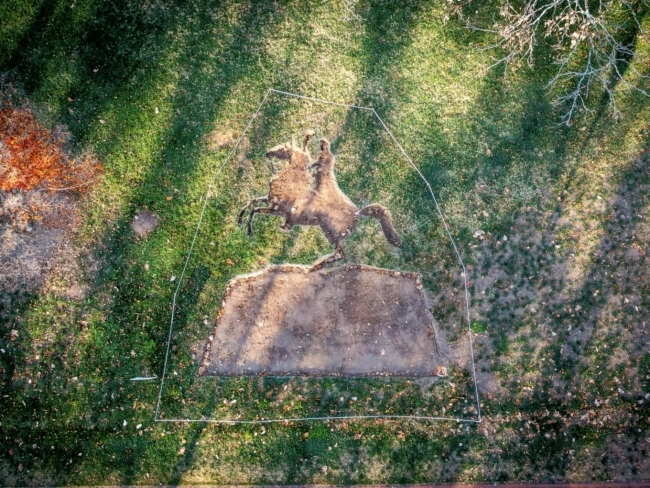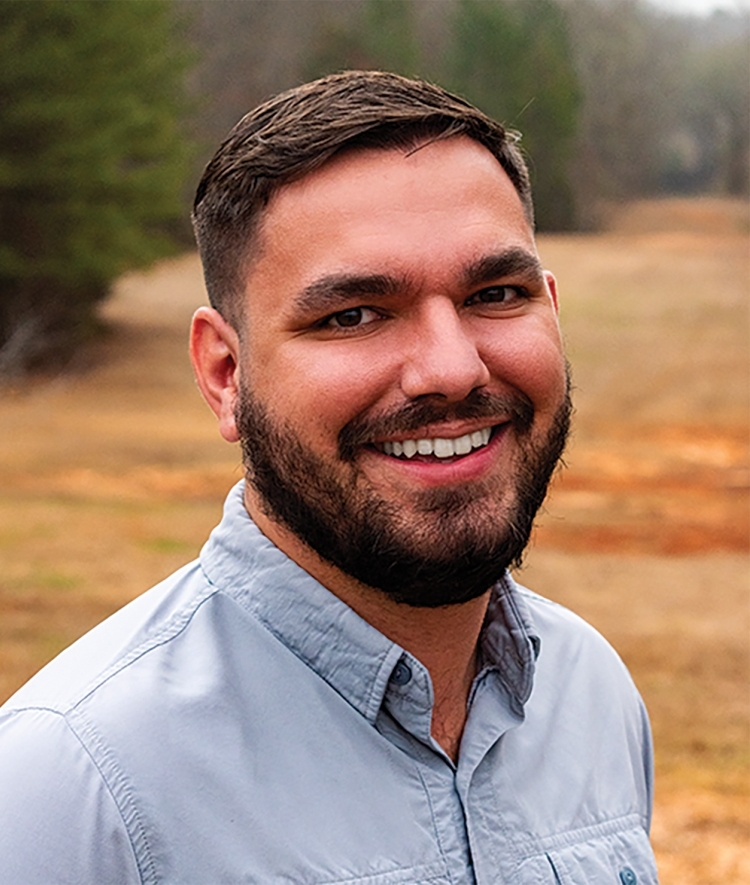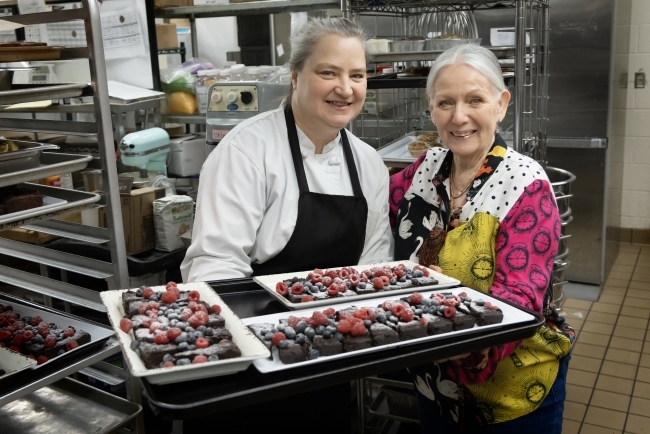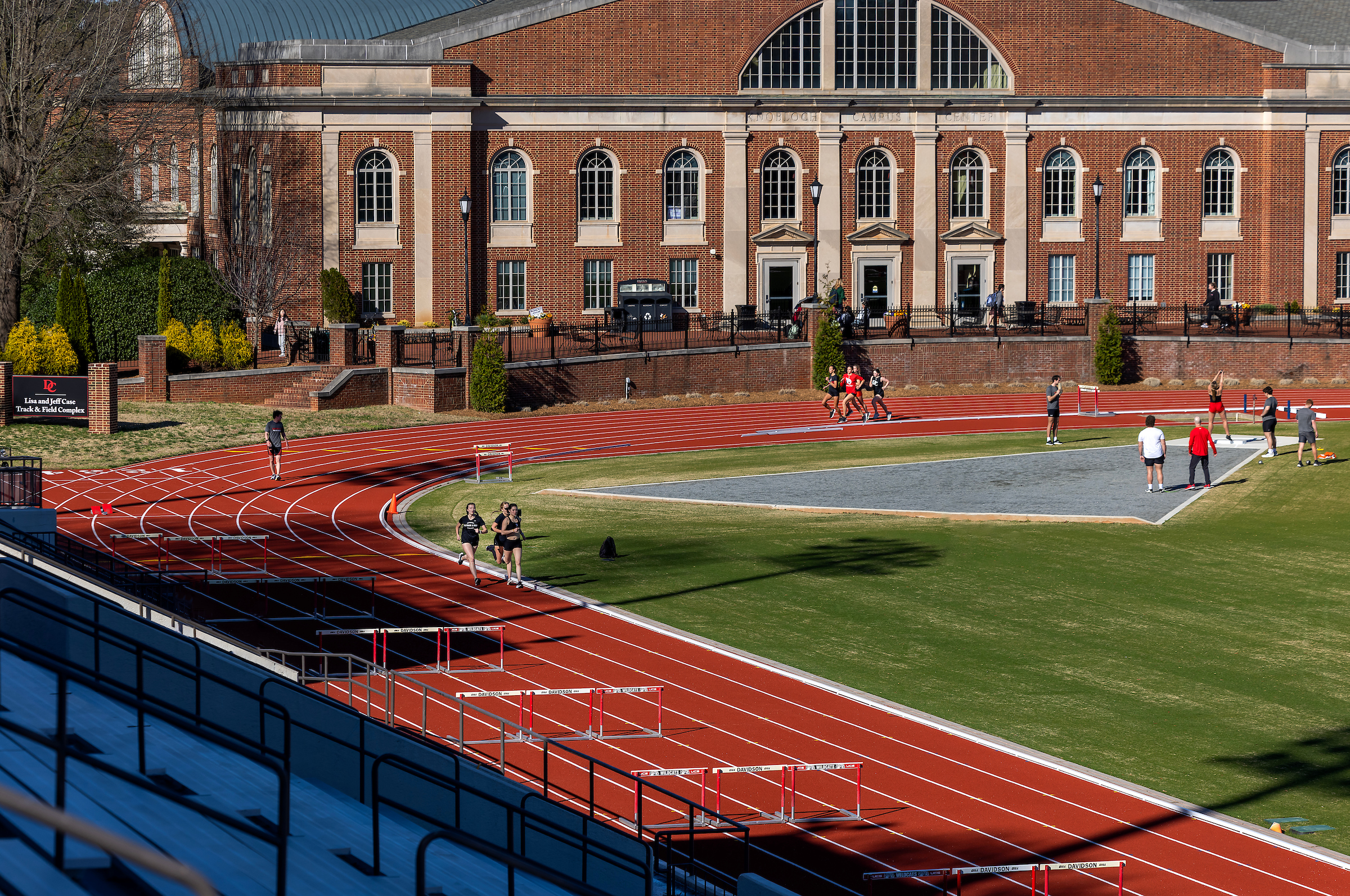Common Ground: A Flourishing Partnership Between Davidson College and the Catawba Nation
May 14, 2024
- Author
- Kathleen Purvis

Roo George-Warren, executive committee member of the Catawba Nation’s government
From a tiny kernel of an idea, the Catawba Nation and Davidson College have grown a corn collaboration into a multi-year interdisciplinary project that stretches from art to history to STEM to agriculture.
In September, the Catawba Nation and the college signed an agreement to work together to grow a once-lost strain of traditional corn, called “kus iswq.” The collaboration supports the Catawba Nation’s expansion of agricultural production, broadens cultural understanding around Indigenous foods, and reintroduces kus iswq into the diets of citizens of the Catawba Nation, based in Rock Hill, South Carolina.
The relationship also provides Davidson students with opportunities for research and service that directly support those goals, furthers the college’s sustainability work, and raises awareness of the role of college founders in the dispossession of Native people.
“As far as I know, we are the only (college) program like this,” says History Professor Rose Stremlau, one of the faculty members who initiated the collaboration. “We get this one little kernel and get to run with it. And that’s a gift and an opportunity.”
Stremlau began working with North Carolina’s Indigenous people at UNC Pembroke, modeling for her students how to engage with Native people to address historic wrongs that shape the present while not assuming that white academics know what Indigenous people need.
In a moment in higher education when many are focused on crafting land acknowledgements and wondering what to say, Stremlau says we should ask what our Native neighbors want us to do.
An Enduring Presence
The kus project is rooted in the Catawba Nation’s long and ongoing presence in the region.
Traditionally an agrarian society that stretched from what is today South Carolina across the North Carolina Piedmont and up into Virginia, the Catawba Nation, known as “yeh is-WAH h’reh,” or “People of the River,” have lived along the banks of the Catawba River for at least 6,000 years.
Well into the 18th century, they planted miles and miles of corn fields. While Catawba women (women have been the farmers in most Native societies) grew multiple varieties of corn, Catawbas especially prized a flour corn that’s ground into cornmeal and grits.
When people see the kus iswq for the first time, they often comment on how beautiful it is, Stremlau says, likening it to a brilliant-colored sculpture.
Throughout the East, white settlers who wanted Native land displaced them by setting fire to their corn fields, creating famines and refugee crises. The practice originated during the colonial era under British policy, but American leaders perpetuated it. Iroquois people in New York nicknamed George Washington “town burner,” for example, and the Rowan militia engaged in this style of warfare against Cherokee people in the Carolinas, Stremlau says.
The land where Davidson College now sits was a part of the Catawba lands taken both through force and fraud perpetrated through the South Carolina court system, which is a topic of research by those in the collaboration. Today, the Catawba Nation numbers about 3,900 people, with a reservation in York County, South Carolina.
Returning Something Precious
From the beginning, the collaboration has included the arts. In 2021, Van Every/Smith Galleries director and curator Lia Newman had invited Alaska Native artist Nicholas Galanin for a solo exhibition. That exhibition, Dreaming in English, included existing and new photos, videos, prints and performative work. Because Galanin was known for his outdoor, ephemeral pieces, Newman invited him to propose such a project for the college.
At that time, Galanin had just completed a headline-generating, large-scale public work in Sydney, Australia, that addressed the complexity of relations between settlers and Indigenous people. His Shadows on the Land entailed the symbolic “burial” of a statue of Capt. James Cook—Galanin was interested in doing something similar in the shape of the famous Washington, D.C., statue of Andrew Jackson, the U.S. president known for his brutal policies toward Native people in the South.
Galanin’s plan was to dig an outline of Jackson’s statue and over time, transition the site of exposed soil into a garden of sweetgrass, but staff from the Catawba Cultural Center and Department of Natural Resources had another idea: plant kus.

Artist Nicholas Galanin’s Unshadowed Land begins to take shape. A variety of Catawba corn, kus iswq, that had been “rediscovered” was planted within the outline, grew and was harvested in 2022.
Catawbas had recently received a small amount of kus iswq. The corn had been “rediscovered” with the help of a family in Hickory, North Carolina, that had been growing a handed-down seed they only knew as “Indian corn.” Botanical historian David Shields helped to identify the corn, and North Carolina State University had a small supply, which they returned to Catawba.
In 2021, Galanin’s Unshadowed Land project came to be on Main Street, a small field dug by students, faculty, and staff in the shape of Jackson’s statue that was planted with kus. More of the corn was planted at The Farm at Davidson, along the east side of campus on Grey Road.
For the Catawba, the corn was more than symbolic. It was the return of something precious, says Roo George-Warren, an executive committee member of the Catawba Nation’s government. He had been working on interviewing tribal elders on what was important to them.
“The thing that came back over and over was, we have to bring back the corn,” he says.
Black Snake Farm, located on the Catawba reservation, grows food for their community, but it is not an ideal location to mass plant kus because of past and current cultivation of modern sweet corn varieties there and on neighboring farms. Caring for kus includes preventing unwanted cross-pollination.
The Farm at Davidson College provided a wonderful solution. Surrounded by a nature preserve and without a recent history of other varieties of corn having been planted there, the college’s fields were an ideal ground in which kus could flourish.
Susana Wadgymar, a professor of biology and a scholar of corn and climate change, worked with farm manager Halle Murphy and Catawba Nation Director of Natural Resources Aaron Baumgardner to reintroduce kus to the land where Catawba women farmers once grew it over hundreds of years.

Halle Murphy

Aaron Baumgardner
With the support of Professor Annie Merrill and students from environmental studies, Wadgymar’s student lab workers, and student farm interns, the team planted and harvested a successful kus crop in 2022.
Murphy, Wadgymar and Baumgardner worked together to increase the yield in 2023. It wasn’t easy — while the corn plots could be protected by fencing to keep out deer, fences didn’t stop crows from swooping in and stealing the seed. Murphy figured out it was better to start seedlings and transplant them into the field.

Susana Wadgymar, assistant professor of biology, works with students in the Peroni Greenhouse.
Another consideration was more aesthetic. The corn kernels come in a variety of colors, which makes for lovely ears. But when it was ground into meal and grits, it came out an unappealing gray color. Catawba and Davidson volunteers sorted out the colors and planted one field in white kernels and another in yellow to select for color varieties for specific food purposes.
This past growing season, there were two vigorous patches growing at The Farm, with stalks rising as high as 8 feet, each topped with bead-like fringe and each one bearing a fat ear of corn with large kernels that range from a deep butter yellow to almost pink. Davidson students worked with Catawba staff to tend to an additional experimental polyculture patch on their farm.
“It was the roughest, readiest corn,” Murphy says with admiration. “It does so much better than organic sweet corn. It’s corn that’s good at being corn.”
“If corn can be beautiful,” says Stremlau, “this is the most beautiful corn you’ve ever seen.”
Expanding the Collaboration

Chef Loretta Barrett Oden, right, a member of the Citizen Potawatomi Nation, worked with college staff to prepare a meal using recipes from her book Corn Dance: Inspired First American Cuisine.
The corn project continues to grow. The college has arranged for artists, historians, cookbook authors and chefs from different Indigenous tribes to come as consultants and educators for both Davidson students and Catawba Nation staff and citizens.
Most recently, Chef Loretta Barrett Oden, a member of the Citizen Potawatomi Nation, worked with college Chef Craig Mombert and his staff to prepare a meal using recipes from her book Corn Dance: Inspired First American Cuisine. She visited campus for a lunch at the college and a dinner at the Catawba Cultural Center.
George-Warren is excited about the possibility of so many ways to use the corn, from getting a nutritious traditional food back into tribal life to using the kus stalks to make corn dolls, a traditional craft.
“The reason it survived so long was we integrated it into our culture,” he says. “The other piece is in our music and dance. We had a green corn dance, and it was part of our ongoing tradition — planting day, harvesting days. Every time I see a new cob, I’m like, ‘the colors!’ There are lifetimes of creativity in there to explore.”
The official agreement between the Catawba Nation and Davidson stipulates that the college will grow the corn and work with the Nation through summer 2025. But Stremlau hopes it won’t end there. She sees helping to restore something so precious to the Catawba Nation as a step toward acknowledging the role of the college’s founding families in the dispossession of Native people in this region and of the Presbyterian church in child separation throughout Native communities in the United States.
She also sees the possibilities of the program continuing in new forms, including adding other traditional plants and woodland management.
“We have students, faculty, and staff with research capacity and the desire to be of service, and our Catawba partners have projects they want done,” Stremlau says. “Pun intended, there’s a lot of common ground here. We are clearing a path to grow this relationship for many, many years.”
This article was originally published in the Spring/Summer 2024 print issue of the Davidson Journal Magazine; for more, please see the Davidson Journal section of our website.


